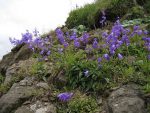 A native of the Caucusus Mountains, sage-leaved bellflower is a herbaceous perennial and a member of the Campanulaceae family that also includes ladybells (Adenophora), balloon flowers, and Lobelia. It has a creeping rootstock and forms clumps of dark green 2-3″ long basal leaves that are ovate -oblong, downy, sharply toothed, and carried on long petioles. The dark purplish blue flowers are bell-shaped, nodding, up to 1 1/2″ long, and appear singly or in one-sided racemes in summer on stems with small lance-shaped leaves. Sage-leaved bellflower is a good choice for a rock garden or border. The genus name, Campanula, comes from the late Latin word campana meaning bell. The specific epithet, collina, comes from the Latin word collis, meaning hill, and refers to its natural habitat.
A native of the Caucusus Mountains, sage-leaved bellflower is a herbaceous perennial and a member of the Campanulaceae family that also includes ladybells (Adenophora), balloon flowers, and Lobelia. It has a creeping rootstock and forms clumps of dark green 2-3″ long basal leaves that are ovate -oblong, downy, sharply toothed, and carried on long petioles. The dark purplish blue flowers are bell-shaped, nodding, up to 1 1/2″ long, and appear singly or in one-sided racemes in summer on stems with small lance-shaped leaves. Sage-leaved bellflower is a good choice for a rock garden or border. The genus name, Campanula, comes from the late Latin word campana meaning bell. The specific epithet, collina, comes from the Latin word collis, meaning hill, and refers to its natural habitat.
Type: Herbaceous perennial
Bloom: Dark purplish blue nodding, bell-shaped flowers up to 1 1/2″ singly or in one-sided racemes in summer
Size: 8-12″ H x 8-18″ W
Light:Full sun to partial shade
Soil: Average, medium moist, well-drained
Hardiness: Zones 5-9
Care: Deadhead to maintain attractive habit and control seed production.
Pests and Diseases: None of significance
Propagation: seed, cuttings, division
Companion Plants:Ornamental onion (Allium cyathophorum var. farreri), Artemisia Silver Mound, alpine pink, wreath nasturtium (Tropaeolum polyphyllum)
i